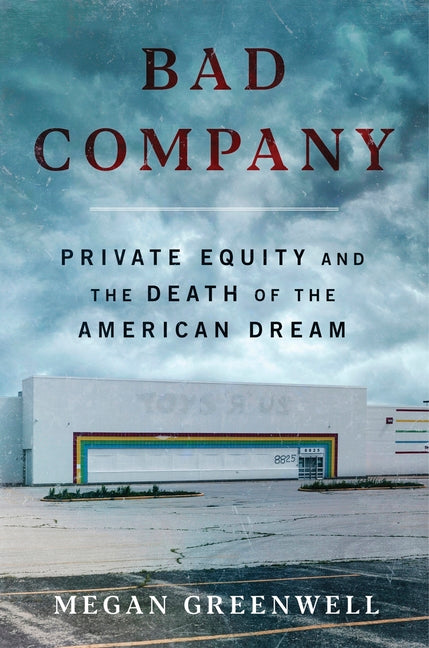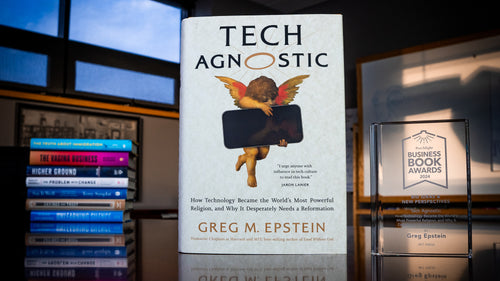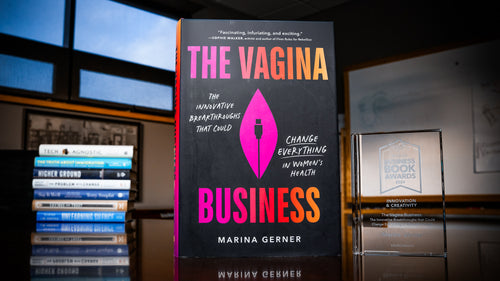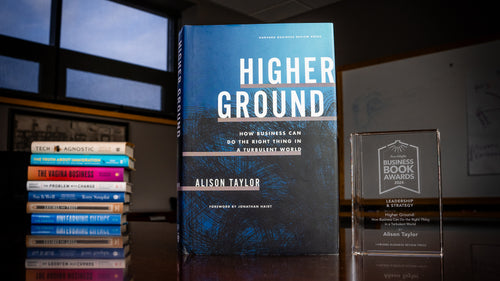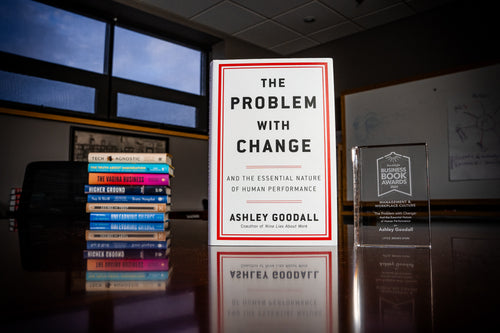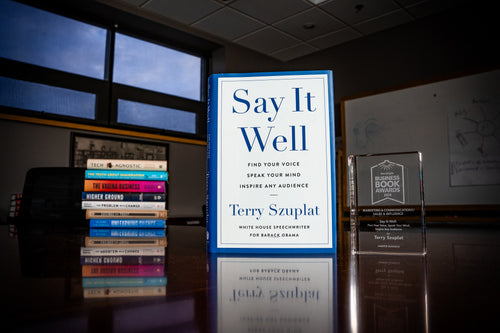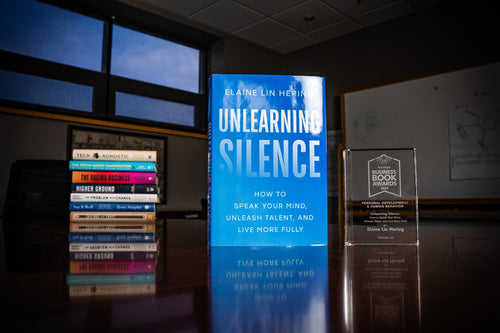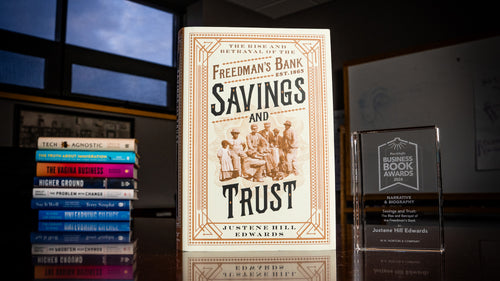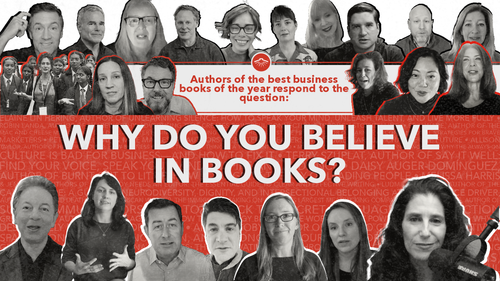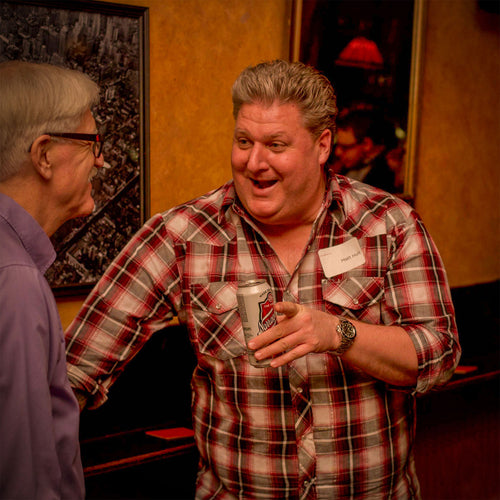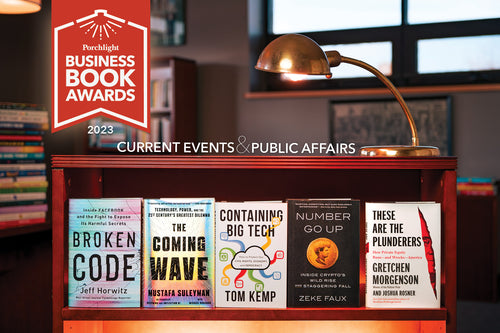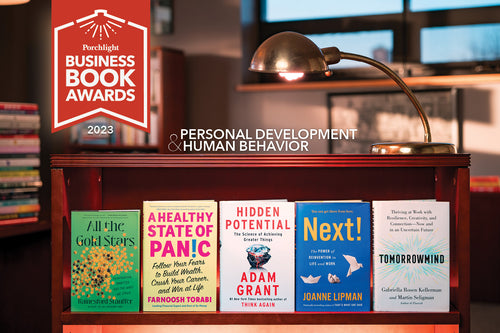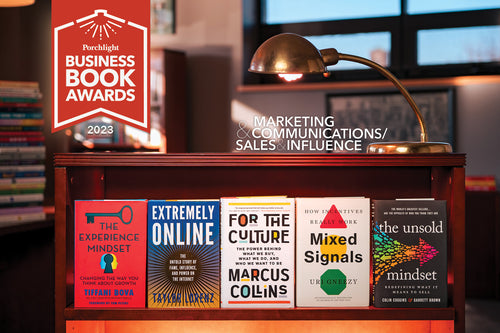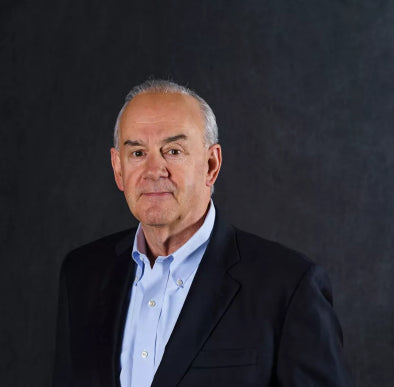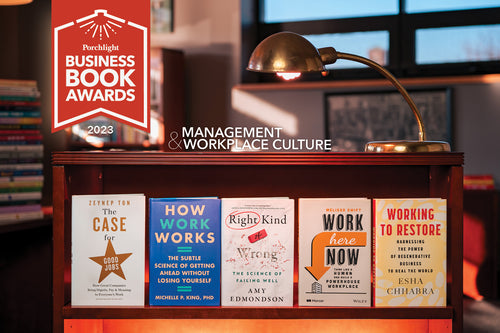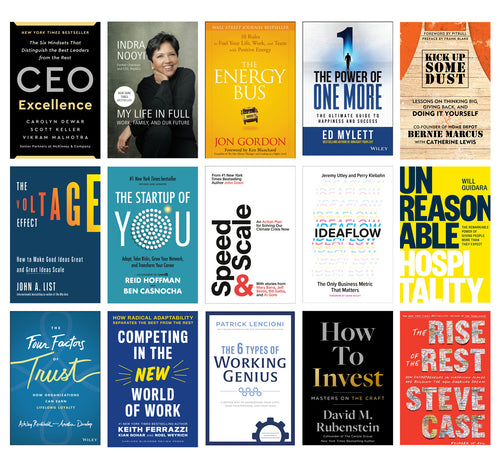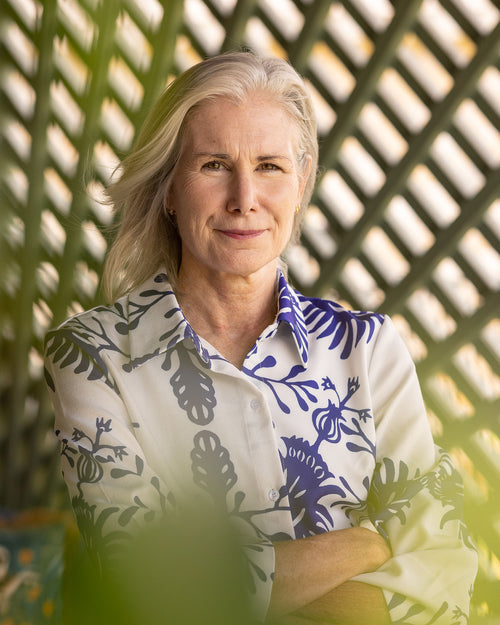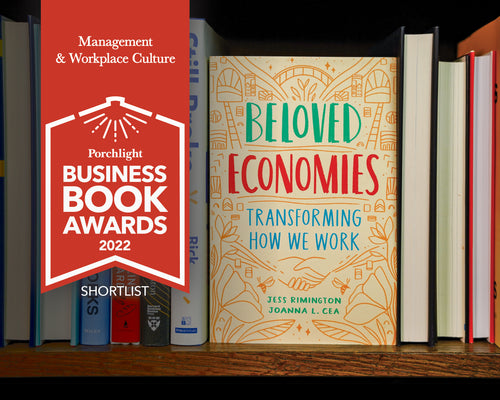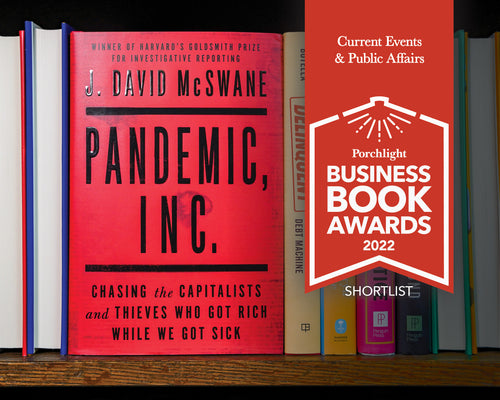The 2023 Porchlight Business Book Awards | Leadership & Strategy
Tennis champion and equal rights advocate, Billie Jean King once said that "Pressure is a privilege.” It’s a quote that surfaced from the back of my mind while reading this year’s submissions in the Leadership & Strategy category. Digging a little deeper into its origins, I found an interview with King excerpted from KK Ottesen’s book, Activist, where King expands upon her well-known quote:
I have this saying: Pressure is a privilege. Usually if you have tremendous pressure, it’s because an opportunity comes along. ... You’ve been dreaming about this moment. Is it a lot of pressure? Yeah. But guess what? It’s a privilege to be standing here. Most of the time, in work or play or anything, if you really think about it, usually it’s a privilege. Give me the ball. Give me the problem to solve. Let’s figure this out. Let’s go.
King always treated tennis like that—a problem to solve. “Tennis taught me so many lessons in life. One of the things it taught me is that every ball that comes to me, I have to make a decision. I have to accept responsibility for the consequences every time I hit a ball.” And, of course, in tennis as in leadership, we don’t always control what comes at us. What counts is how we perform under pressure. Leaders step up when the opportunity presents itself and make the effort to solve whatever problems come at them. The best leaders appreciate that they are in the privileged position to act, and to influence, if not control, the outcome. And they “accept responsibility for the consequences” of their decision-making. Still, it feels like leaders today are under more pressure than ever to adapt their style, their values, and their actions to a rapidly changing business culture.
I suspect that our collective feeling of uncertainty among leaders is due to the fact that, more than ever before, running a business is less about the entity itself, and more about the individuals that make up the entity. A combination of technology and the pandemic hastened this shift. Instead of forcing employees to fit within the structure of a company, employees have a greater hand in shaping the structure. Leaders are being asked to change, to modernize their thinking, to not rely on a set of antiquated standards. How do you set policy, expectations, performance requirements, business metrics, and communication standards while fostering a vibrant and creative culture for an entity that is more amorphous and less easily controlled? Or maybe more succinctly, how do you lead controlled chaos? Sure, there have been progressive leaders over time who have embraced people-centric practices, but now leaders must offer employees even greater degrees of autonomy and opportunities for asynchronous work than ever before… and boy, does that feel uncomfortable.
The answer doesn’t lie, however, in trying to put the genie back in the bottle. Instead, the answer lies in creating a future in which we don’t need genies to make our wishes come true—we just need brave leaders who are willing to change and are up for the challenge, who say, as Billie Jean King did: “Give me the ball. Give me the problem to solve. Let’s figure this out. Let's go.”
The following five Leadership & Strategy books will help us do just that. We’ve got work to do and problems to solve and, in these pages, we can discover where our own leadership habits might need to evolve, develop an effective game plan and the renewed confidence to execute it. These books encourage us to shed obsolete mores, be more agile and adaptive, creative and brave, so we can make the most of this opportunity to respond to the people who commit their time and effort to our companies, and in doing so, evolve those companies into resilient entities of the future. It’s a privilege to be standing here, striving under the pressure to become the kind of leaders our companies and employees need us to be.

Head & Heart: The Art of Modern Leadership by Kirstin Ferguson, Berrett-Koehler Publishers
This year in the Leadership & Strategy category, we had upwards of 150 books submitted. One common theme was a call for leaders to improve on and engage with what were once considered the “soft skills” of leadership—empathy, compassion, vulnerability, curiosity, self-awareness. Kirstin Ferguson’s Head & Heart addresses them all and insists that leaders embrace these traits as part of "modern" leadership, acknowledging that it requires us to make more room for variance and nuance and treat leadership as more an art than a science:
Understanding that work is an innate part of being human is critically important for modern leaders and explains why some of the most challenging experiences for modern leaders are found when humanity and work collide.
Our first step, she encourages, is to be open to learning. “Modern leaders are not perfect. Far from it. Leading, like living, is a series of missteps and challenges, setbacks and lessons learnt.” For example, one of the pressing concerns of leaders is remote work. While there are obvious benefits of remote or hybrid work for both employees and employer, many companies and employees are also experiencing a loss of connection that occurs more naturally when people work together in person. “There is a close relationship between purpose and place—people draw meaning and ownership, energy and commitment because of a strong sense of alignment with the place in which they live and work.” So leaders need to ask themselves, “If you want people to come into your work space, what kind of feeling are you hoping they are being injected with by the time they leave?” This is exactly the kind of problem that modern leaders are trying to solve, problems with no clear binary answers.
Struggling to understand what is expected of you now as a leader? This book will help you get a toehold so that you can begin your own necessary transformation.
READ AN EXCERPT FROM THE BOOK HERE.
How Big Things Get Done: The Surprising Factors That Determine the Fate of Every Project, from Home Renovations to Space Exploration and Everything In Between by Bent Flyvbjerg & Dan Gardner, Currency
As leaders face pressures to adapt our companies to a new way of doing business day to day, and reshape our workplaces and our expectations on what performance and productivity looks like, we still need to get sh*t done. How Big Things Get Done tells us how.
Flyvbjerg and Gardner first remind leaders, project managers, and even home owners alike that “Projects are not goals in themselves. Projects are how goals are achieved. People don’t build skyscrapers, hold conferences, develop products, or write books for their own sakes. They do these things in order to accomplish other things.” The first step to seeing a big project from start to finish is identifying the ‘why.’ Many big projects go off the rails or balloon out of proportion when we lose focus on why we began the project in the first place. Keeping the goal in mind will keep the project moving toward the desired outcome.
The authors also contend that we often rush the project planning stage. “People say that projects “go wrong,” which they all too often do. But phrasing it that way is misleading; projects don’t go wrong so much as the start wrong.” And that’s because, “We are a deeply optimistic species. That makes us an overconfident species,” the authors say. Working against that tendency to underplan because we are ever-hopeful and ever-tempted to skip to the good stuff is how big things actually get done to plan.
The authors end the book with eleven heuristics that include such universal advice as “Think Slow, Act Fast;” “Say No and Walk Away;” and “Know that the Biggest Risk is You.” How Big Things Get Done offers terrific storytelling, actionable advice, and psychological and sociological insight into project planning and management, whether you are trying to lead a project to change your company, your software, or the layout of your kitchen.
READ AN EXCERPT FROM THE BOOK HERE.
Lead Together: Stop Squirreling Away Power and Build a Better Team by Tania Luna, Peakpoint Press
Let’s get this out of the way first: Lead Together: Stop Squirreling Away Power and Build a Better Team is, yes, a story about squirrels. A business allegory to be more precise. Whether a parable (think The Goal by Eliyahu Goldratt) or a fable (think Who Moved My Cheese by Spencer Johnson), writing business fiction is a risky business. Oftentimes, the conceit itself distracts or overwhelms the message. Tania Luna avoids this pitfall by doing what good comics do—the more the comic commits to a bit, the more authentically the bit is delivered and then experienced by the audience. Here, Luna knows what she’s asking from us, and she doesn’t back down, filling this tidy little book with many a woodland pun, but building her tale on a solid framework of scientific research.
The story begins with this important line: “Sam Squirrel was almost definitely a great leader—at least according to himself.” Sam pridefully defines his prowess at being a leader by a simple metric: he and his team consistently gather the most acorns. But what happens when conditions in the forest change for the worse and everything Sam thought made him a good leader is put to the test? The rest of the fictional story follows the common arc of the business fable. Our hero is figuratively lost and searching (in this case, Sam is literally lost in a forest) and soon meets a guru Mary who introduces Sam to the “power-with” way of leading. She explains: “The power-with way just has two parts: grow person power and distribute power well so it’s not too concentrated in any individual or group.” Sam is skeptical, but because he is desperate to try anything, he is willing to change his mind and his approach to leadership.
This theory of “power-with” leadership (and Mary the squirrel guru herself) is modeled after Mary Parker Follet, who is often referred to as “the mother of modern management,” and whose work in the early 20th century is all too little recognized today. We often overcomplicate leadership, but a book as accessible and applicable as Lead Together is a straightforward tool to share with everyone on your team and in your organization to bring about one critical change—empowering people so that everyone leads together.
READ AN EXCERPT FROM THE BOOK HERE.
Move Fast and Fix Things: The Trusted Leader's Guide to Solving Hard Problems by Frances Frei & Anne Morriss, Harvard Business Review Press
In addition to its being a functional book, Move Fast and Fix Things is a fun and funny book, a personable book. The reason I highlight this is because we (and I’m speaking about business book readers generally) don’t tend to think humor and/or humanness belongs in the serious business of organizational change. If we are talking about problems, then we better get serious. And of course the material here is serious, but it’s rare for a business book to be as authentic as the authors themselves, as you might experience them while listening to their podcast or watching their TedTalks. Within these pages is a methodology for making things better in your organization, but it’s also an enjoyable reading experience dotted with poetry reference and personal anecdotes.
Morriss and Frei open Move Fast & Fix Things by stating something that may seem obvious, but rarely discussed: “Leadership is the practice of imperfect humans leading imperfect humans.” And “if you accept this as a reasonable starting point, then it follows that any collection of us builds imperfect organizations.” The acceptance of our fallibility can be incredibly freeing. Doing so deflates the ego, levels the hierarchy, creates a feeling of common purpose, and recognizes the humanness inherent in running and working for a business.
The structure of the book is based on a “days of the week” approach to solving problems fast.
Welcome to Monday, both a metaphor and—like the rest of this book—a suggestion we’re making in good faith. You could wait for a more sentimental moment to begin your adventure in organizational change, such as the start of the year or the annual partner’s meeting. Or you could receive the gift of renewal that comes around every seven days, also known as Monday.
So on ‘Monday,’ we must identify the real problem that is holding us back; Tuesday, we solve for trust; Wednesday, we make new friends (inclusion); Thursday, we tell a good story; and Friday, we go as fast as we can. This construct reminds the reader of how quickly a problem can (and should) actually get addressed. We aren’t going for perfection here, but progress.
For Morriss and Frei, one of the reasons organizations remain stuck is because leaders take too long to solve problems and they urge us to “reject the tentative, foot-dragging pace of change that often masquerades as prudence but is typically just slow.” Unfixed problems are a slow-moving toxin that spreads through the bloodstream of a company and becomes much more invasive than the original issue itself. In the company of Morris and Frei, you’ll feel empowered to tackle even the most formidable and deep-rooted of organizational problems and “be more effective at the core task of leadership, which is to create the conditions for other people to thrive.”
READ AN EXCERPT FROM THE BOOK HERE.
The Right Call: What Sports Teach Us about Work and Life by Sally Jenkins, Gallery Books
I opened this survey of my top Leadership & Strategy books of 2023 talking about sports. And I close with a book, Sally Jenkins’ The Right Call, that speaks far more eloquently about the intersection between sports leadership and business leadership. In a chapter on “Culture,” Jenkins quotes Golden State Warriors coach Steve Kerr: “I would say coaching is maybe 25 to 30 percent strategy. Everything else is about communication and what your players feel when they come into the building every day.” This can be said for any company that wants to build a winning team culture.
I also found reading The Right Call refreshing because in her exquisitely written and well-researched effort to “describe the athletic heart,” she tells us stories of ambition and rigor and intense investment of time and effort—how humans push themselves to succeed for the thrill of competition, the ecstasy of winning, and the love of the game. There are some people who really do live to work, as many athletes do, and get tremendous satisfaction and purpose doing so. We shouldn't leave them behinds as we also struggle to solve such persistent workplace issues as burnout or work/life balance.
Successful leaders, like coaches, like point guards, like Billlie Jean King, want to lead. They are serious students of the role, making an effort daily to improve themselves while also improving their people and their companies. In a chapter on “Candor,” Jenkins asserts that the very best leaders “communicate from honest centers with ears for others and tongues that avoid blame, and this allows them to form powerful alliances.” In fact, she continues:
The right words have broader implications for us than just facilitating better decision processes in an office or workplace. They tell us a lot about whom we want to work for, and who we want our leaders and our problem solvers to be.
The book is redolent with illustrative sports stories that illuminate the potential that leaders have for becoming the best at what they do. And it’s invigorating to talk straight up about striving, about pushing oneself, about being all-in and when the time is right, not holding back. She writes: “When you choose a profession for love, you find that last invisible measure, the one that can vault you into a more imaginative state than just digging a trench for pay.” Maybe our efforts won’t take us to the pinnacles of performance like professional athletes—we can’t sink a three-pointer with one second on the clock in the final game of a series, or slap down an ace on match point at Wimbledon—but to fully invest ourselves in our work, to ask for the ball time and again, and to discover those hard-earned moments of excellence, well, then all those hours of practice and all of those years spent honing our craft may turn out to be the right call after all.
READ AN EXCERPT FROM THE BOOK HERE.






























